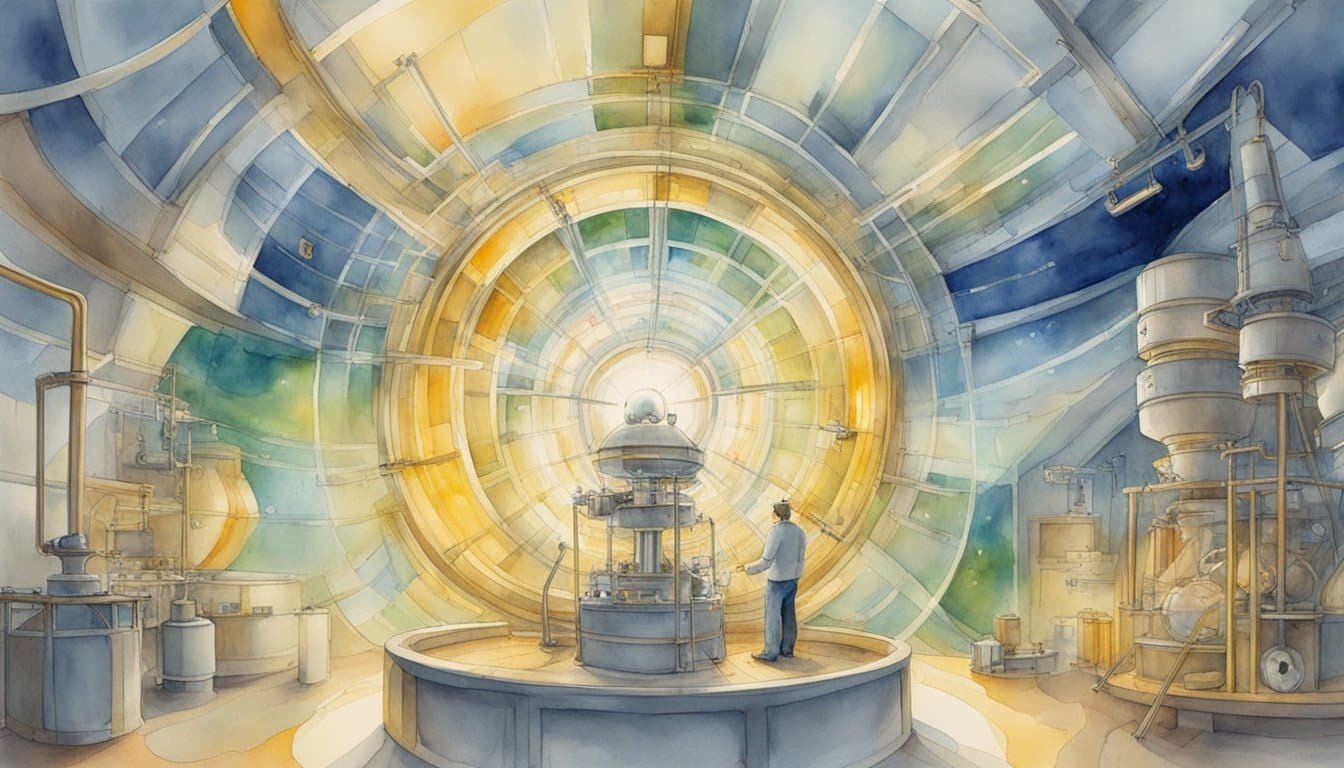Fundamentals of Nuclear Fusion
Nuclear fusion stands at the forefront of potential energy sources for the future, harnessing the power that fuels the stars. This process involves light atomic nuclei merging to form heavier ones and releasing incredible amounts of energy.
The Fusion Process
Fusion occurs when two light atoms, typically forms of hydrogen like deuterium and tritium, collide at high speeds. For these nuclei to fuse, they must overcome their electrostatic repulsion, a barrier due to their positive charges. When this happens, a heavier nucleus, usually helium, is formed along with the release of a neutron and a massive amount of binding energy.
Fusion Fuel and Resources
The most effective fuels for fusion reactions are isotopes of hydrogen: deuterium and tritium. Deuterium can be readily sourced from seawater, while tritium is scarcer and often bred during the fusion process itself. The fusion of these isotopes yields a helium nucleus, free neutrons, and more energy per gram than any other conventional energy source.
Fusion vs Fission
While both fusion and fission involve the nucleus of an atom, they operate quite differently. Fission splits a heavy atom into lighter ones, releasing energy in the process; it has been the basis for nuclear power plants for decades. Fusion, on the other hand, combines light nuclei like those of hydrogen to form heavier elements such as helium, with even greater energy output and without the long-term radioactive waste associated with fission.
Fusion Technology and Experiments

Diving into the realm of nuclear fusion, technologies and experiments serve as the backbone of a potentially revolutionizing energy source. Here, layers of complexity give rise to a fusion of science and innovation.
Approaches to Fusion
Drawing from the power of stars, scientists pursue various methods to achieve fusion energy. The most prominent approaches involve heating fusion fuel, often isotopes of hydrogen like deuterium and tritium, to extreme temperatures where nuclear force takes over, allowing nuclei to overcome repulsion. Two primary devices in the pursuit are tokamaks and stellarators. Tokamaks, like the ITER facility, use a combination of intense heat and powerful magnetic fields to confine plasma in a doughnut shape. Stellarators aim for similar goals but with a twisted toroidal design to maintain plasma stability.
Notable Projects and Experiments
Groundbreaking experiments have carved a path toward viable fusion energy. The ITER facility, international cooperation aiming to create the largest tokamak ever, is crucial for testing the viability of sustainable fusion energy. In the USA, facilities like the National Ignition Facility (NIF) take a different tack, using lasers to achieve ignition, where the energy generated outpaces that needed to start the reaction. Japan contributes with their experiments such as those done with plasma facing components at the Tokamak Fusion Test Reactor, expanding knowledge on managing fusion’s high energy and neutron output.
Challenges and Advancements
Fusion technology faces numerous hurdles, such as sustaining the high temperature and pressure needed for fusion or coping with intense neutron bombardment. Yet, advancements like superconducting magnets incrementally push forward the efficiencies of tokamaks. The Eurofusion consortium represents Europe’s collective effort toward overcoming these obstacles, developing materials and technologies robust enough to handle fusion’s demanding conditions. As layers of complexity unfold, each experiment inches closer to a breakthrough, opening potential doors to a clean and abundant source of energy that could power our future.
Fusion Energy and the Future

Nuclear fusion, the same process that powers the sun and the stars, stands poised to potentially revolutionize how energy is generated on Earth. Fusion promises an abundant source of clean energy, with far fewer environmental ramifications is compared to fossil fuels.
Environmental Impact
Fusion energy has the potential to significantly reduce the amount of greenhouse gases released into the atmosphere. Unlike conventional power plants that rely on fossil fuels, fusion energy does not emit greenhouse gases which are major contributors to climate change. Moreover, it produces minimal radioactive waste in contrast to nuclear fission reactors, mitigating the long-term waste disposal challenges currently faced by the Earth. For instance, the Lawrence Livermore National Laboratory has been at the forefront of research with the US National Ignition Facility, advancing knowledge in the field of inertial confinement fusion.
Path to Commercialization
Progress towards realizing the dream of fusion power generation has been steady, albeit slower than some advocates might hope for. The technologies of magnetic confinement and inertial confinement have seen considerable advancements thanks to organizations like the Commonwealth Fusion Systems and General Fusion, driving us closer to the goal of fusion commercialization. Heavy isotopes such as deuterium and tritium play a critical role in fusion reactions, yet ensuring an adequate supply of these materials is integral for sustaining future fusion power plants. The energy density of fusion is incredibly high—a fact that underscores its vast potential and also its application in thermonuclear weapons. Nonetheless, transforming fusion into a practical, everyday clean energy source continues to be a sophisticated challenge, intertwining scientific breakthroughs with engineering feats.

